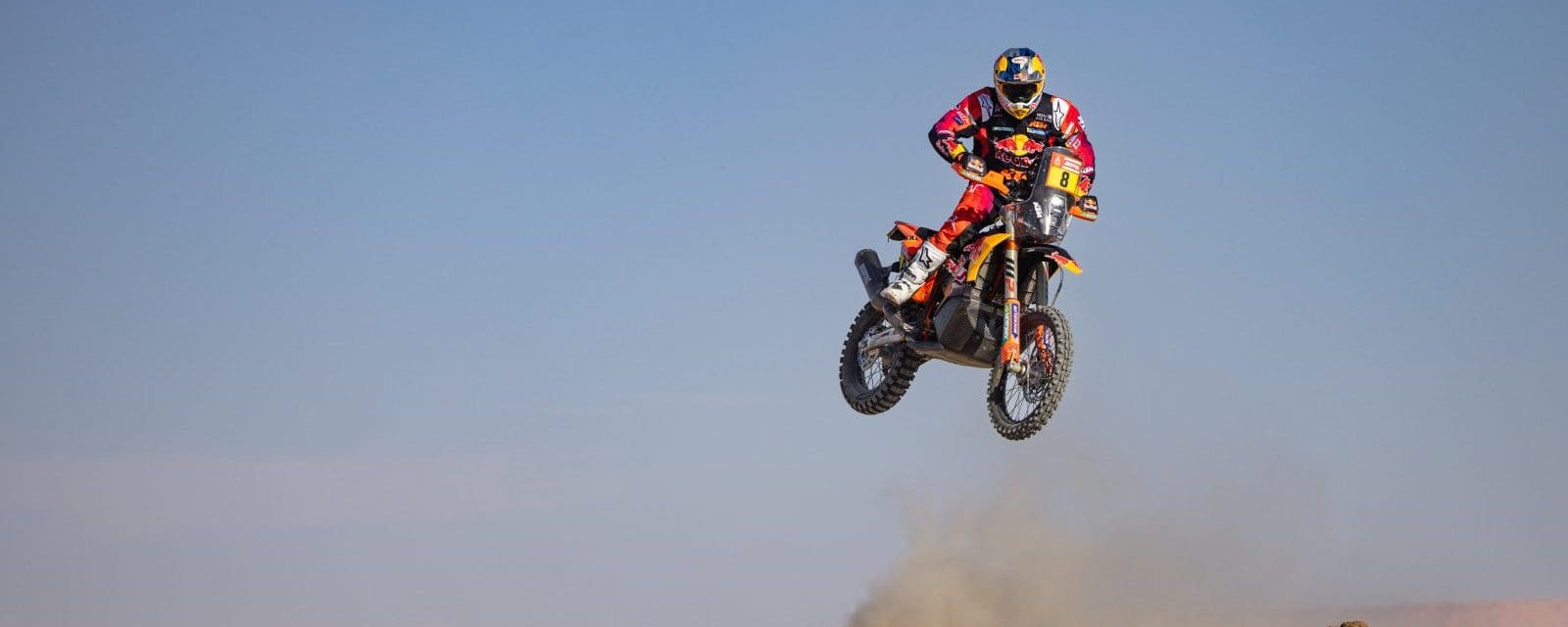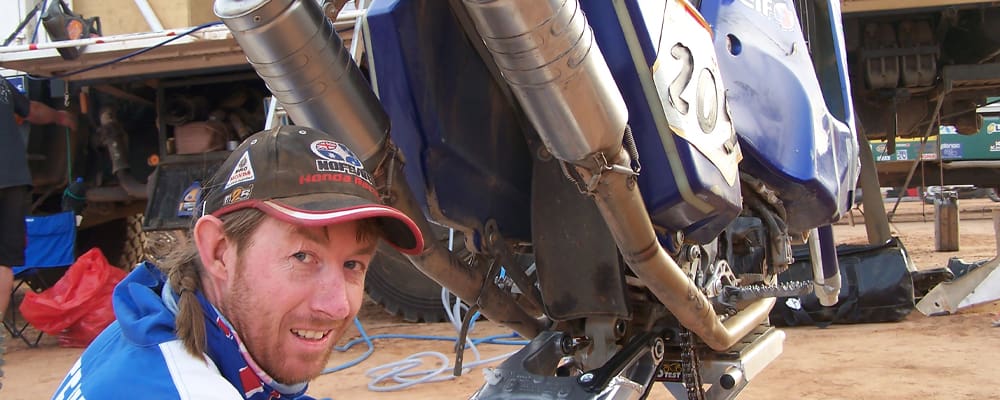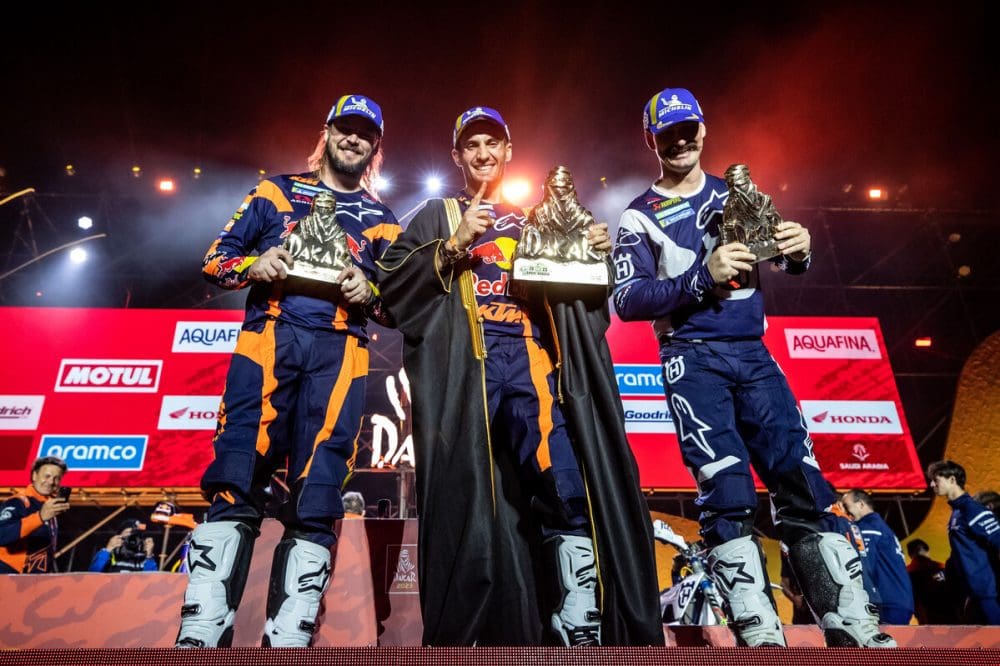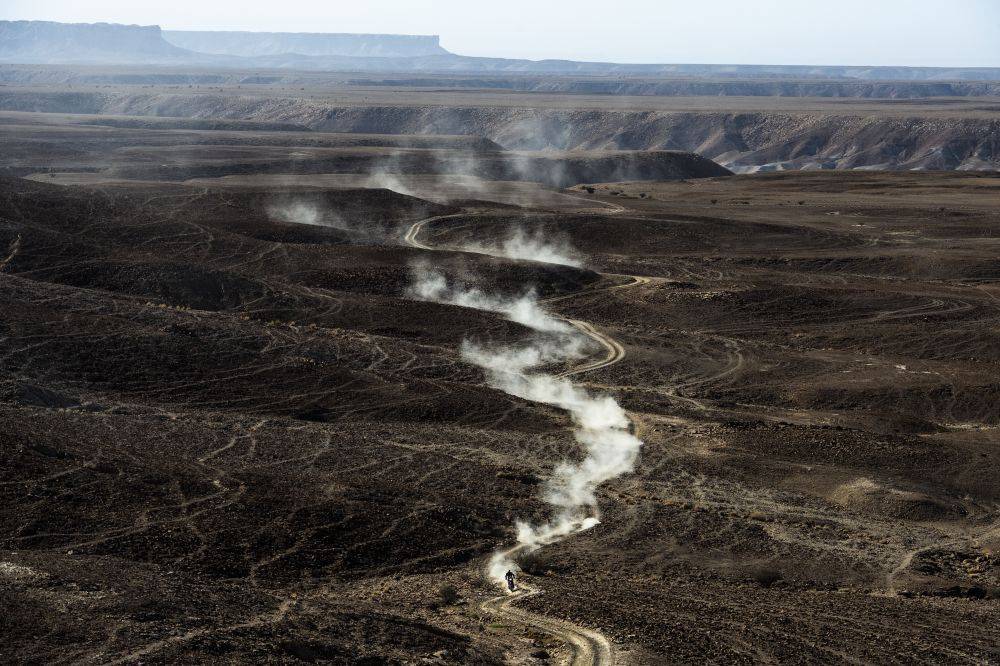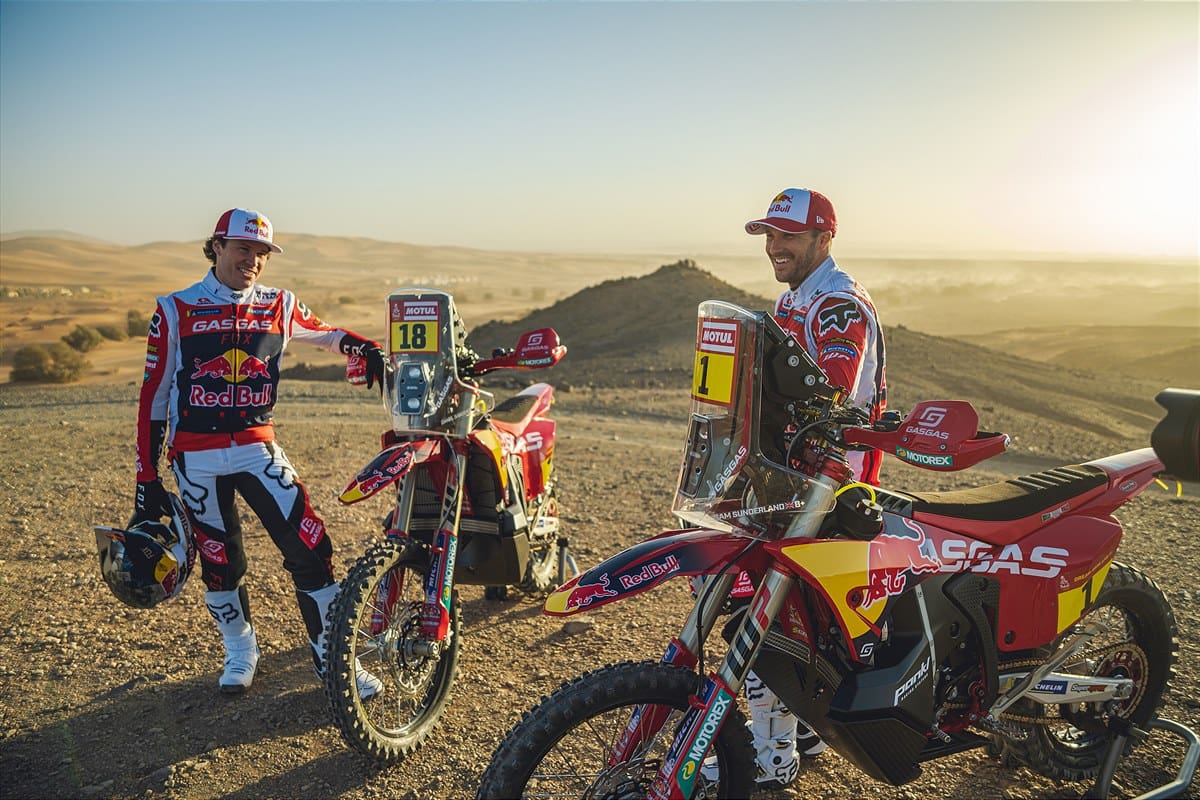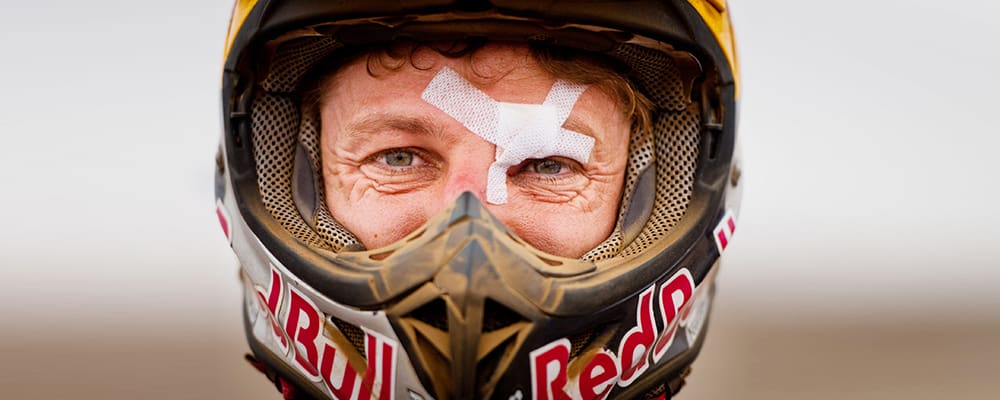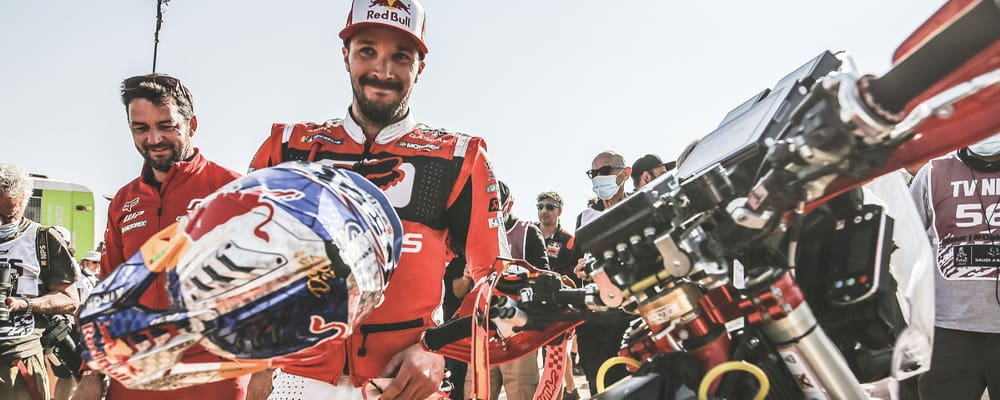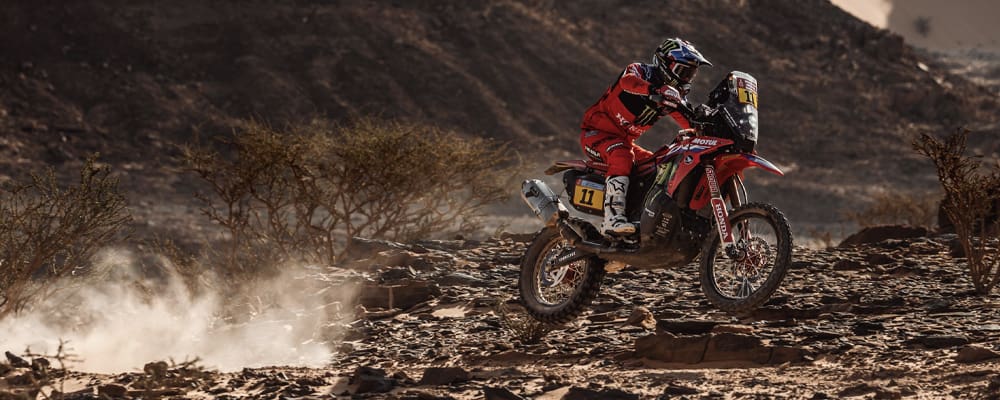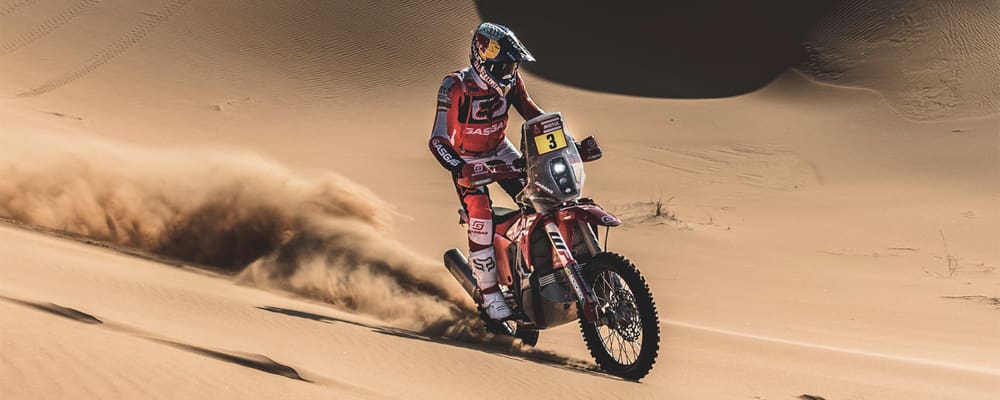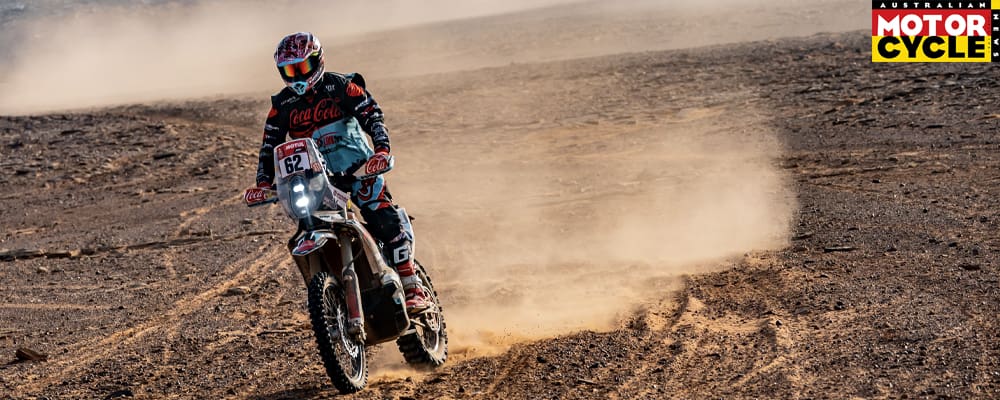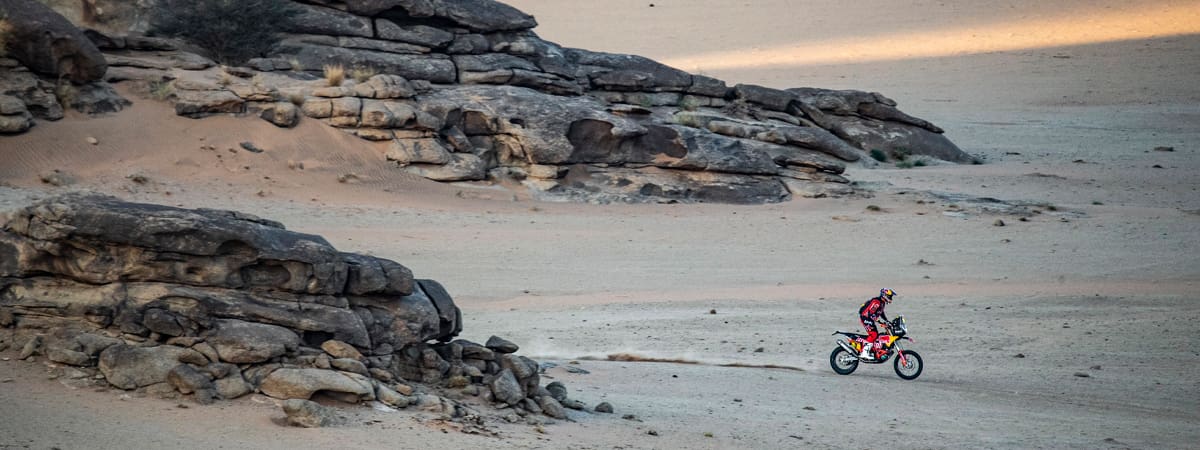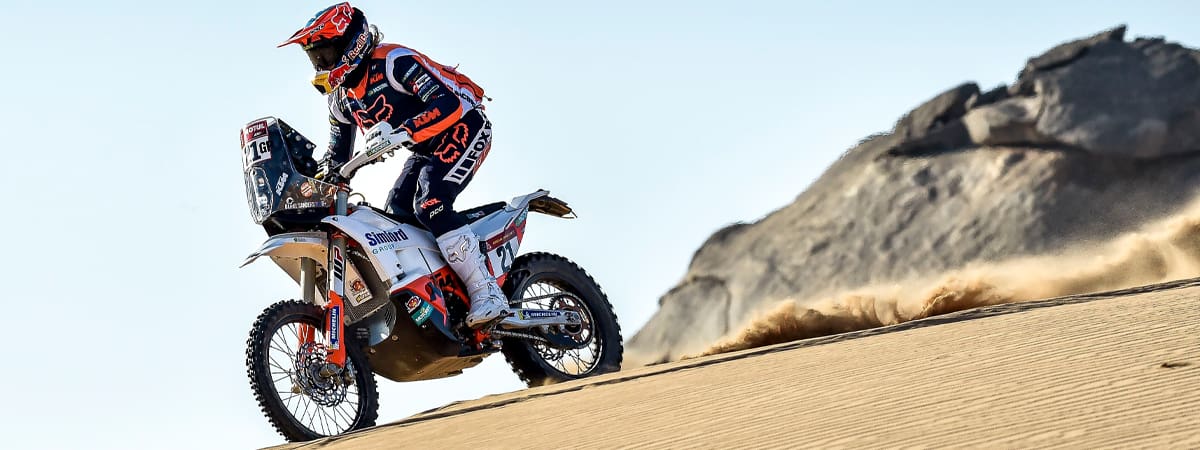Andrew Houlihan’s got a hell of a lot of healing to do and not much time to do it before Dakar 2022. At the end of July, the 52-year-old Albury local and all-around good bloke crashed his heavily customised KTM 890 R Rally while training. Cresting a rise at an estimated 160km/h, he hit not one, but two kangaroos, and snapped his bike in half. As well as four broken ribs and broken bones in his hand, he broke his neck, fractured an eye socket and punctured a lung which then collapsed.
At a time when most other 50-something-year-olds would call time on an international racing career, this bloke used his time in hospital to start planning a one-off custom build he’s calling a KTM 890 Dakar R. And Dakar 2022 is less than 100 days away.
Houlihan didn’t start riding bikes until later in life. At 33 years old, he and his wife Katie spotted a banged-up pair of Yamaha DT175s for sale on the side of the road and thought it might be fun to learn to ride. The following year he joined the Albury-Wodonga Motorcycle Club and thought he’d have a crack at motocross and flat-track racing. The next few seasons saw him achieve good results – and a few broken bones – at both the Victorian and National titles.

In 2017, Houlihan decided he wanted to try his hand at desert racing and signed up for the Finke Desert Race. He and four mates made a trip out of the event and so packed up their adventure bikes and rode from Albury to Alice Springs – across the Simpson Desert. Even though his knee was worn out and in need of replacement, and he’d never ridden a desert before, Houlihan figured if he could cross the Simpson on a 240kg, 147hp KTM 1190 Adventure R with 55 litres of fuel and his camping gear strapped to the back, surely the Finke couldn’t be too bad.
Katie had dragged his KTM 350 XC-F 2300km out to Alice for him, he raced it down to Aputula and back, and soaked up the atmosphere of the iconic Australian event. With wall-to-wall bikes, buggies and race trucks surrounded by thousands of people drawn together for the love of desert racing, Finke is a week-long party.

Once the dust settled, he bid Katie goodbye, jumped on his 1190 and rode home to Albury via the Simpson.
Having the worn-out knee fixed soon after Finke, Andrew’s doctors told him to stay off the bike for eight to 12 months. Which he had every intention of complying with until Aussie desert racer Scott Britnell had the idea to throw some bikes in a shipping container and spend a month riding around Mongolia. At that point, Andrew knew his doctors wouldn’t be happy with him.
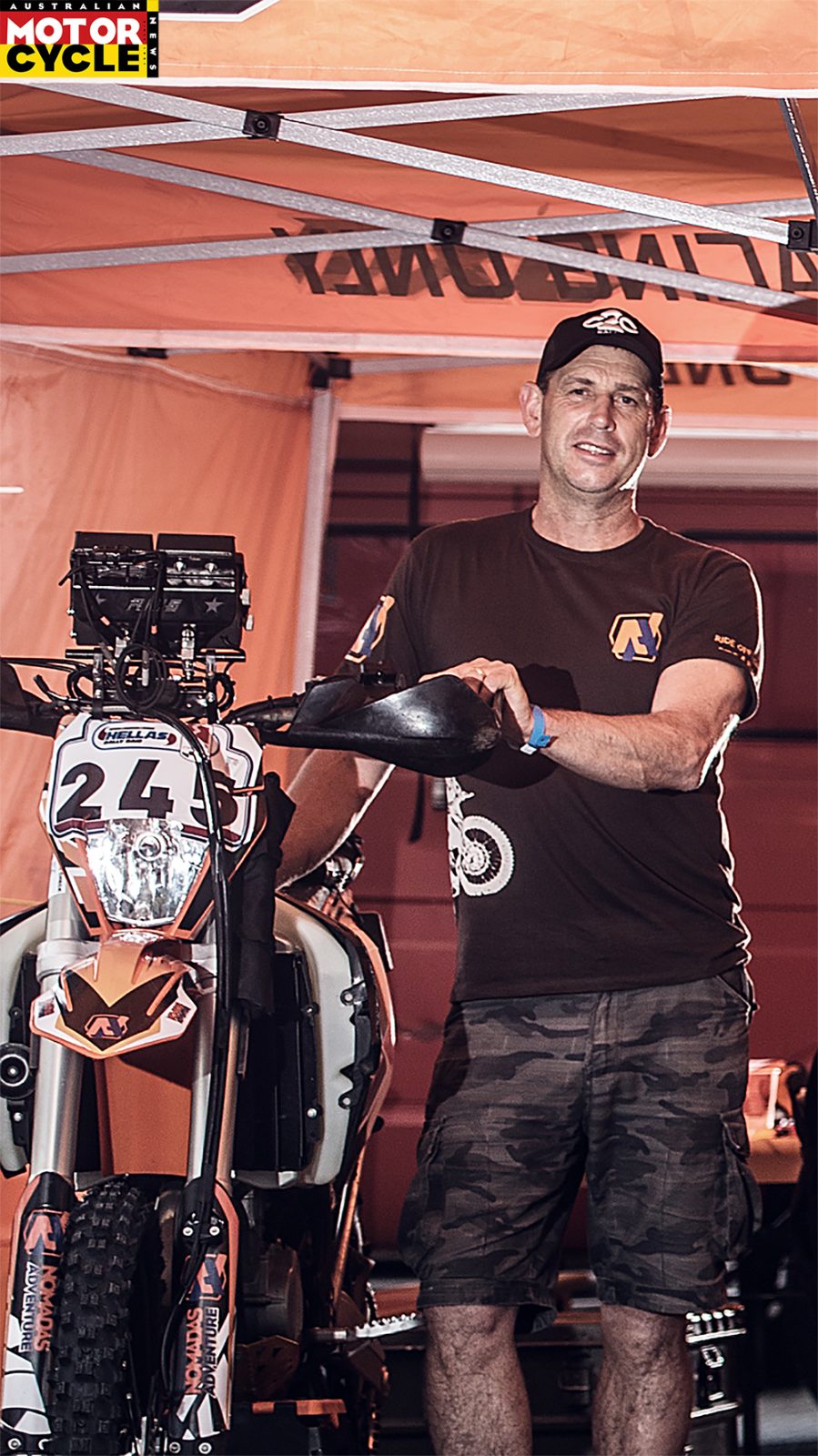
Mongolians look at land ownership differently than we do and the vast majority of the country is unfenced and unregulated, you can ride wherever you want and the places you can go are limited only by your talent and ability to get there. With a rented 4×4 in tow that met up with the group every few days, Britnell, Houlihan and others rode across wild plains, mountain ranges and river valleys.
At night they camped under the stars or pulled up at a hut and for a few bucks, the locals would let them sleep on the dirt floor. They bought food wherever they could find it and everybody got sick at least once – sensitive Western bellies don’t stand a chance against the iron guts of the Mongols. For Houlihan, this trip opened his eyes to the wonders of riding overseas and the possibilities of adventures that were still to come.

Andrew’s first attempt at a navigational event and his introduction to the Nomadas Adventure racing team was the 2018 Hellas Rally in Greece. On the final day of the seven-day event and less than 100km from the finish line, Andrew rounded a corner to find another rider had become lost, had turned back and the pair collided head-on at racing speeds.
Doctors arranged for a low-altitude medical flight to take the other rider to a major hospital in Italy but Houlihan’s injuries were too severe to be transported safely. As well as a broken neck, sternum, nose, eye socket and right hand, X-rays revealed he’d broken his shoulder blade into 15 pieces. At least one of his nine broken ribs had punctured his lung resulting in a pneumothorax.
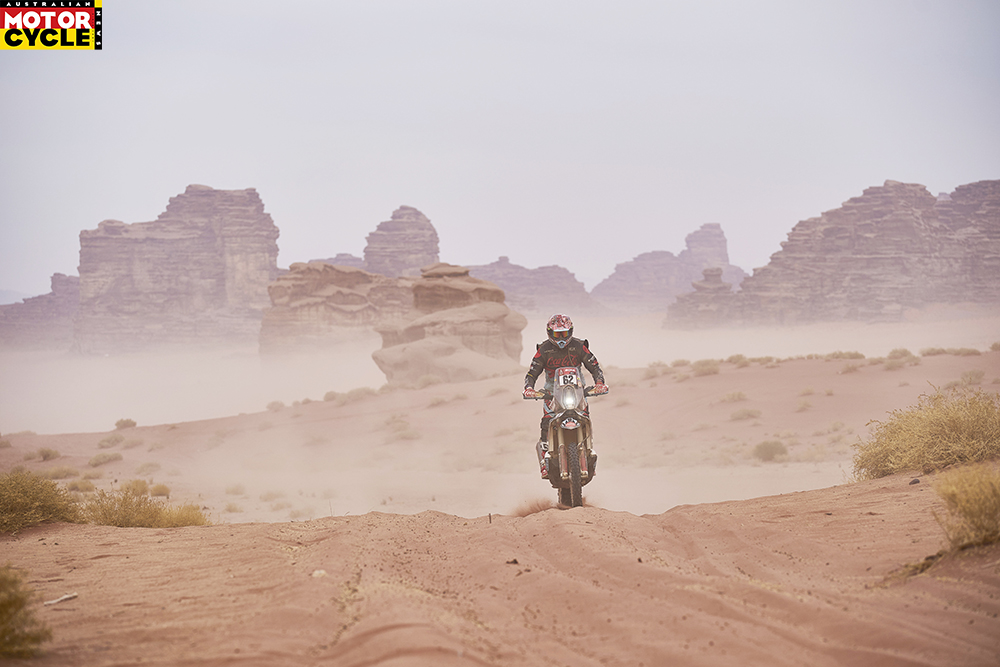
After four weeks in a Greek hospital, an Australian doctor flew over and monitored him during the trip home. Houlihan smiles as he recalls the plane ride with a drain tube running out of his chest. “That was uncomfortable,” he says. After a few more weeks in hospital, he started rehab and the first of many corrective surgeries. This time the doctors told him to stay off the bike for at least two years.
Less than 12 months later he’d been to Spain and back for the five-day Hispania Rally and was gearing up for another go at Hellas when he blew out his right knee during a training accident. A complete replacement was required. But with the trip all booked and paid for, Houlihan went anyway. Each day the Nomadas team would prepare his bike and hold it for him, while he hobbled over on his crutches, climbed on and took off. He made it three days into the rally before he was forced to withdraw.
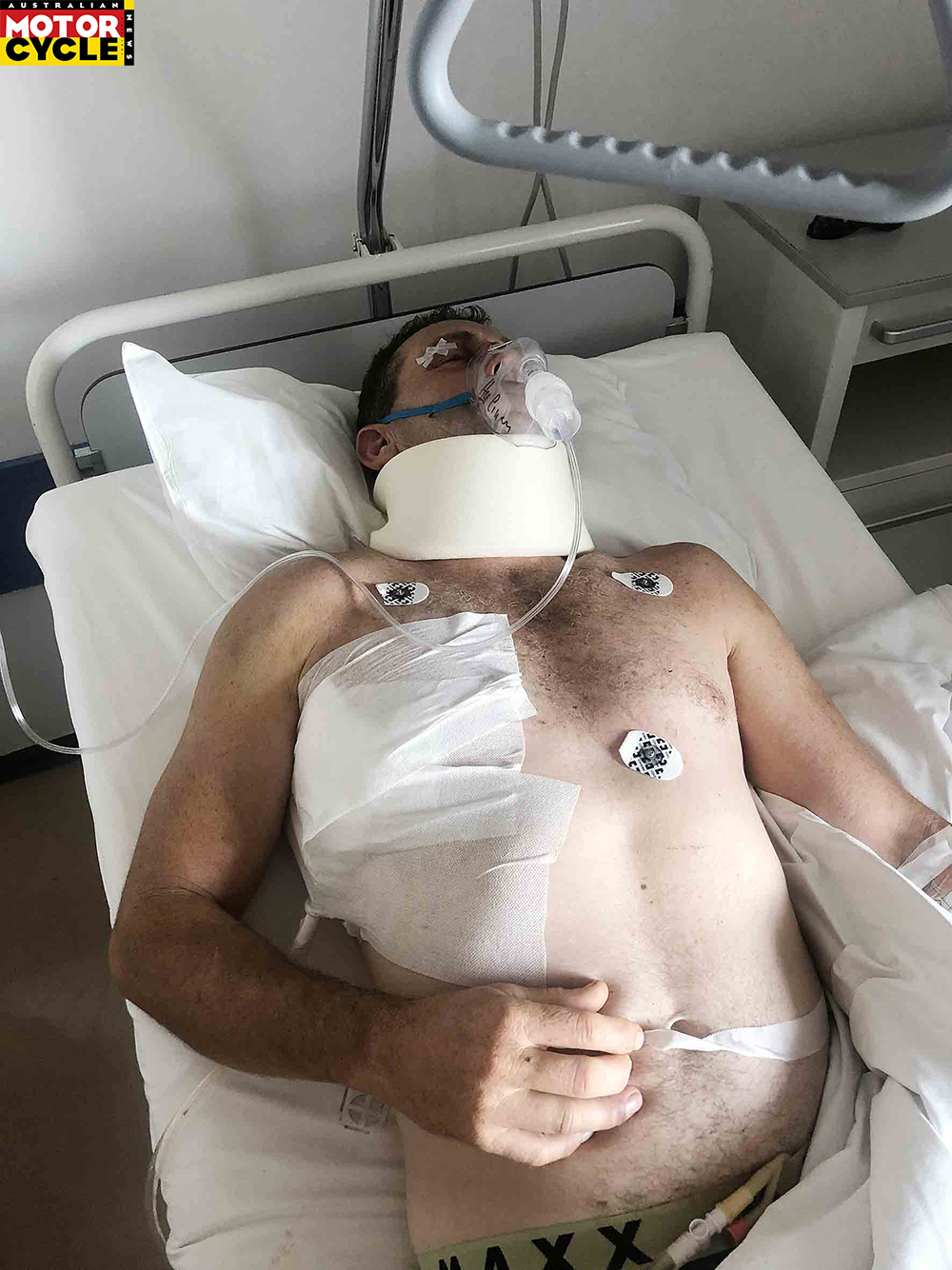
Another knee replacement behind him, he headed back to Northern Africa for the Pan-Africa Rally followed by the Rally Du Maroc. By now he’d set his sights on Dakar and was working his way towards qualifying for it. You can’t just pay your entry fee and rock up to the Dakar Rally, there’s a strict application process and the organisers review a competitor’s race history and results.
With a decent result in the five-day Rally Du Maroc under his belt, Houlihan was now eligible to apply for entry to the Dakar. But after another few weeks at home and a desire to consolidate everything he’d learned about roadbook navigation and sand riding, he was on his way to the Africa Eco Race.
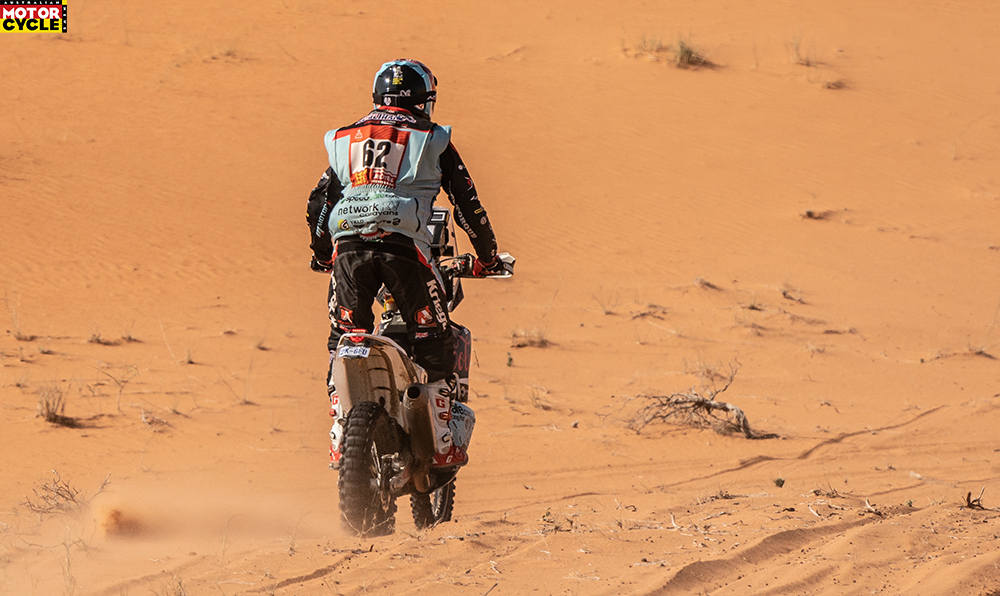
The 12-day rally was wild, rough and incredibly difficult. The days start around 4 am and finish late at night, that’s if you’re lucky and don’t get lost. On the same day, the desert can throw deep snow and steep dunes at you and it’s not uncommon to crest a dune to find crashed bikes buried to the handlebars, their exhausted riders trying to dig them out.
Without the glitz and glamour of the Dakar Rally, Africa Eco Race organisers choose bivouacs far from cities and it’s not unusual to see competitors eating and sleeping on the sand without the resources and big support teams you’d see at other events. Finishing 21st overall and confident, Houlihan had guaranteed himself a spot at Dakar, but as he travelled home he heard the first whispers of a new illness people were falling sick to called Covid-19.
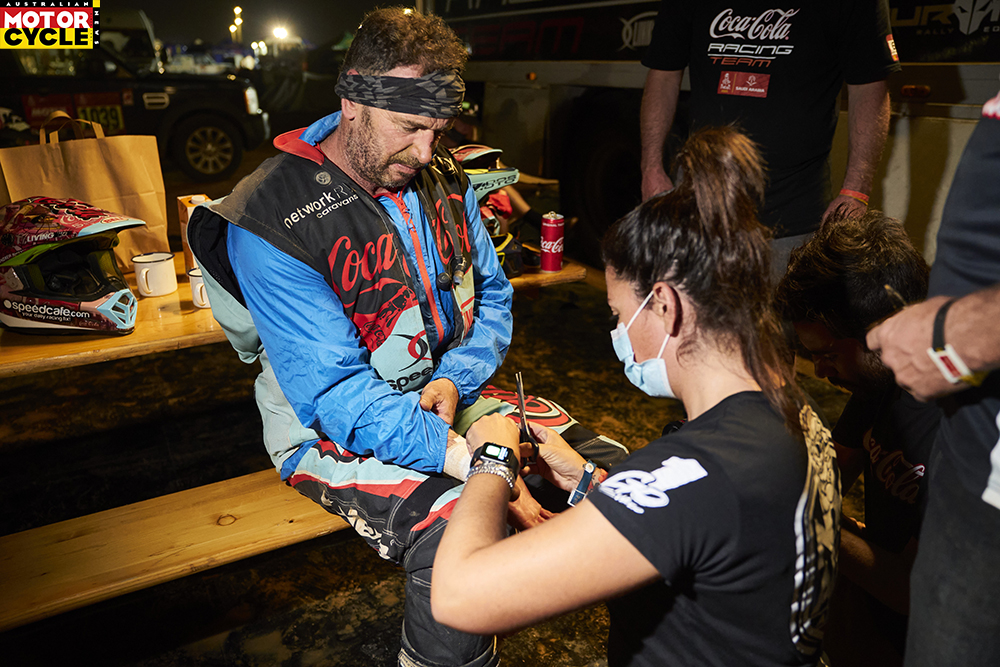
The world changed overnight and international travel was almost impossible. While Andrew’s Dakar application was successful, he was prevented from any further overseas rally training, so he used the time to catch up on some surgery and have one of his partially-attached thumbs repaired. A few other trips under the knife allowed some long-overdue maintenance to be done on his body and he spent the rest of 2020 focused on his fitness.
Having to seek approval from the Australian government just to leave the country earlier this year meant his trip to Saudi Arabia was more than a little complicated. The Saudi government closed its borders to outsiders less than two days before the rally, so Dakar organisers chartered 13 planes to transport staff and competitors into a quarantine bubble where they all isolated and were tested. On the third day of racing, a small crash sent Houlihan over the handlebar and resulted in another fracture in his right wrist.
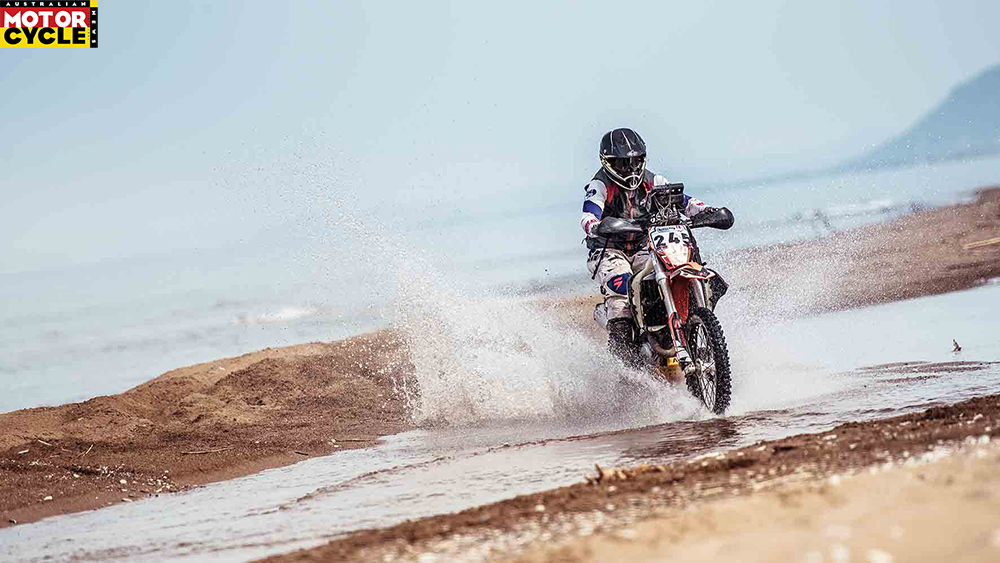
The riding was the toughest he’d ever experienced and consisted of deep sand one day and rocks the next. Rocks everywhere, one section might consist of 10km of basketball-sized stones that felt like they were covered in oil. Navigating in this environment got harder and harder, following a compass bearing through unmarked boulder fields or virgin desert sands, you only need to vary a degree or so over a few kilometres before you’re well and truly lost.
On day six, a rock thrown from Carlos Sainz’s buggy hit him and fractured his ankle. Now with a fracture in his wrist and in his ankle, he continued on regardless for the remaining six gruelling stages. One hundred and one riders lined up to start the first stage of the 2021 Dakar rally and only 63 riders made it to the end. Andrew Houlihan finished 50th overall and that was one hell of an achievement.
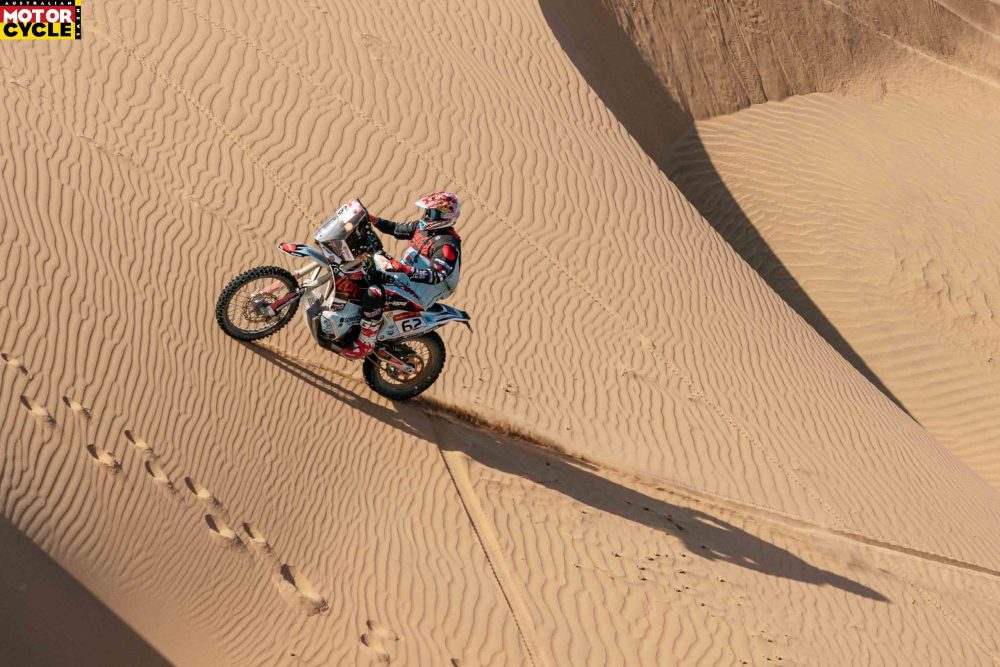
With border closures and lockdowns combined with international travel effectively cancelled in 2021, Andrew’s training came to a grinding halt after his most recent crash. It’s hard not to wonder whether the riding experience is worth the physical cost of the injuries but Andrew laughs when asked.
“I just love riding, mate.”
This is why he has his eyes set firmly on Dakar 2022. And while there are no KTM 890 R Rally machines left in the world, he’s remaining very coy about exactly what he’s got planned, but he did say it’ll be something truly diabolical.
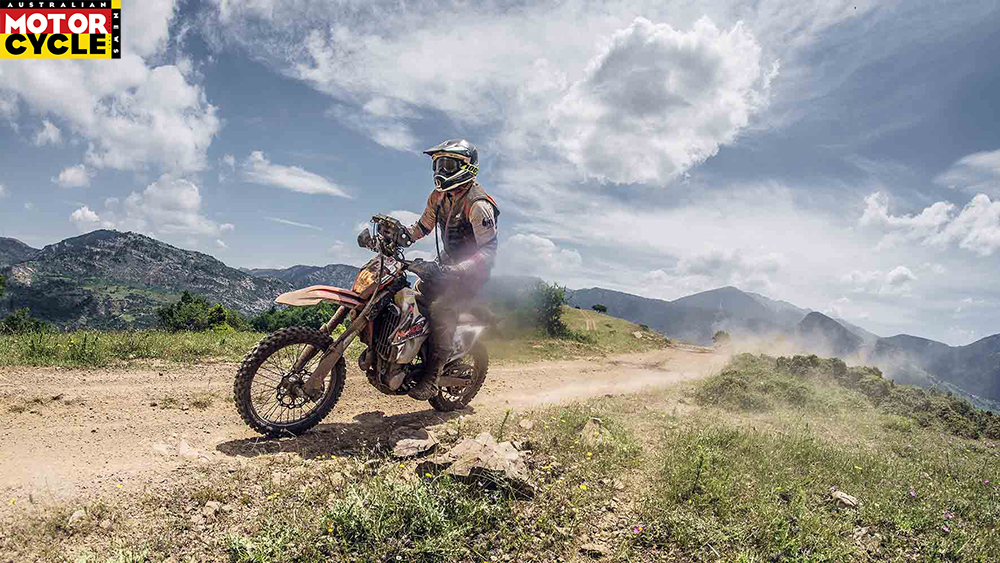
Practice [bike] makes perfect
How to turn an 890 R Rally into a Dakar Rally practice bike
One of only 700 produced worldwide, KTM say its 890 R Rally is ‘a specialised motorcycle for a hardcore Adventurer’. The Austrian firm reserved 200 units for North America and the rest of the world had to share the remaining 500.
They sold out in 48 hours.
Houlihan’s once-intact practice bike started life as a rare but impressive bit of gear at Future Sport Motorcycles in Townsville, Queensland. With his first Dakar Rally behind him and his KTM 790 Adventure recently written off in a crash (something he seems to be making a habit of…), he was on the hunt for a new ticket to adventure.
With his sights set on Dakar 2022, Andrew needed a bike that he could spend thousands of hours and tens of thousands of kilometres training on, then jump onto his KTM 450 Rally Replica without too many problems adjusting.
Straight out of the box, the KTM 890 R Rally is impressively equipped. The narrower wheels support a 48mm WP XPLOR PRO Cone Valve fork and shock that isn’t too far off the spec the KTM Factory Rally team uses.

The centrepiece and most striking visual change was the Aurora Navigation Tower and Rally Roadbook with Baja Designs headlights. The kit uses a combination of OEM and aftermarket CNC components in a rugged, frankly bad-ass design. With it, Houlihan can operate any number of electronic mapping devices or his old-school paper roadbook as seen below.
The standard 20L fuel tank provided around 215km range in the deep sandy deserts of North West Victoria and Houlihan had a variety of options to extend it, including bolt-on twin Ryan rear tanks and hooks to strap fuel bladders too. Just like his racebike, he used every available space to store spare parts and tools so he’s self-sufficient if he needs to carry out repairs in remote areas.
Luggage was taken care of with a Kriega rear platform that can accommodate several different-sized bags depending on his needs and western Sydney graphics designers MotoKit created a near-perfect copy of his KTM 450 Rally Replica stickers complete with corporate signage and sponsorships.
The seat was raised and re-foamed locally and underneath, the air filter was switched out for a full intake and foam filter replacement system.

When one became two
All KTM’s 890 Rallys are sold, and crunching two roos at 160km/h destroyed Houlihan’s
Once Future Sport Motorcycles had finished building Houlihan’s practice bike in Townsville it went on a truck to Brisbane where Andrew flew to meet it. With his riding gear in a shopping bag, he unloaded the bike off the truck on the side of the road, got dressed and set off for Albury. The plan was to avoid sealed roads as much as possible – of the 1400km return journey, 1100km was dirt roads, forest trails and farm tracks.
In the 12 weeks since he took delivery, Houlihan clocked 10,000km on the 890. His training program consisted of at least 2500km every weekend and a further seven hours a week studying and building practice roadbooks.

Houlihan was entered in the four-day, 1200km Sunraysia Safari, a navigation rally due to be held in the south-west New South Wales before it was curtailed by Covid for the second consecutive year.

Shame, too, because seeing him line up alongside 450cc and 500cc enduro weapons on a 200-plus-kilo twin-cylinder adventure bike would have been awesome to watch. Unfortunately, though, lady luck already had other ideas. Seven weeks later he suffered the whopper practice crash that left he and his bike in far too many pieces.
There might not be any 890 Rally bikes left for sale, but he’s already put the Future Sport team to work sorting a suitable replacement.
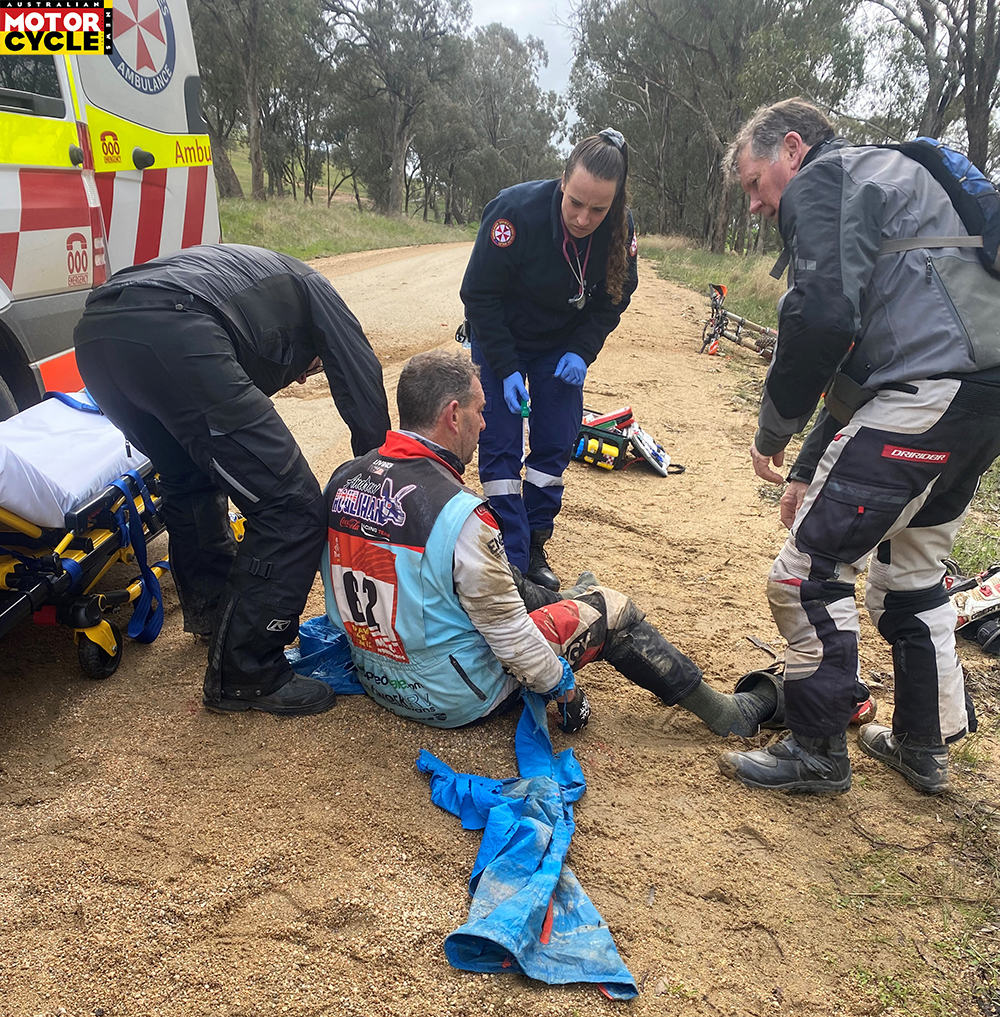
You can follow Andrew’s journey to Dakar 2022 on his webpage www.roadtodakar.com.au or via social media.

Words Bryn Rogers Photography BR & Andrew Houlihan ARCHIVE
